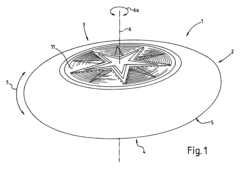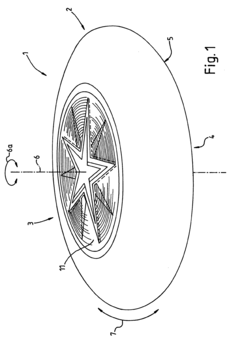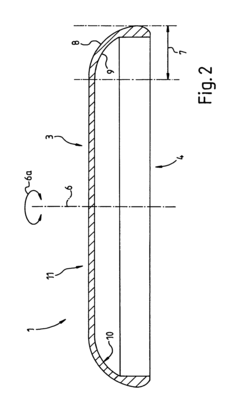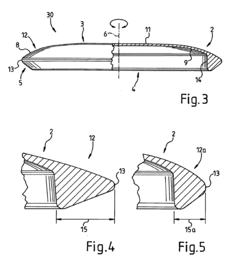Biodegradable Plastics In Sports Equipment Sustainability
Biodegradable Plastics in Sports: Background and Objectives
The field of biodegradable plastics in sports equipment has gained significant attention in recent years, driven by the growing concern for environmental sustainability in the sports industry. This technological domain has evolved from initial experiments with biodegradable materials to the development of high-performance, eco-friendly alternatives to traditional plastics used in sports gear.
The journey of biodegradable plastics in sports equipment began in the early 2000s, with researchers exploring natural polymers like starch and cellulose as potential substitutes for petroleum-based plastics. However, these early attempts often resulted in materials with inferior mechanical properties and durability, limiting their practical applications in sports equipment.
As environmental awareness increased and technological capabilities advanced, the focus shifted towards developing more sophisticated biodegradable materials that could meet the rigorous performance standards required for sports equipment. This led to the exploration of various biopolymers, such as polylactic acid (PLA), polyhydroxyalkanoates (PHAs), and thermoplastic starch (TPS), which showed promise in terms of both biodegradability and mechanical properties.
The evolution of biodegradable plastics in sports has been marked by several key milestones. These include the introduction of biodegradable golf tees in the mid-2000s, the development of compostable sports bottles, and more recently, the integration of biodegradable materials into complex sports equipment like running shoes and protective gear.
The primary objective of research in this field is to create biodegradable plastics that can match or exceed the performance characteristics of conventional plastics while significantly reducing environmental impact. This involves addressing challenges such as improving tensile strength, impact resistance, and longevity of biodegradable materials under various environmental conditions typically encountered in sports applications.
Another crucial goal is to optimize the end-of-life scenarios for these materials, ensuring they can decompose efficiently in industrial composting facilities or natural environments without leaving harmful residues. This aspect is particularly important given the diverse contexts in which sports equipment is used and disposed of.
Furthermore, researchers aim to develop scalable and cost-effective production methods for these biodegradable alternatives, making them economically viable for widespread adoption in the sports industry. This includes exploring innovative manufacturing techniques like 3D printing with biodegradable filaments and investigating the potential of bio-based feedstocks to create more sustainable supply chains.
As the field progresses, there is also a growing emphasis on creating circular economy models for sports equipment, where biodegradable plastics play a crucial role in reducing waste and promoting resource efficiency. This holistic approach not only focuses on material development but also on redesigning products and systems to maximize the benefits of biodegradable plastics in the sports sector.
Market Demand for Sustainable Sports Equipment
The demand for sustainable sports equipment has been steadily increasing in recent years, driven by growing environmental awareness among consumers and stricter regulations on plastic waste. The global sports equipment market, valued at $89.7 billion in 2020, is expected to reach $108.7 billion by 2025, with a significant portion of this growth attributed to eco-friendly products.
Biodegradable plastics in sports equipment represent a promising solution to address sustainability concerns. Consumers are increasingly seeking products that align with their environmental values, leading to a surge in demand for eco-friendly sports gear. A survey conducted by Nielsen in 2019 revealed that 73% of global consumers would change their consumption habits to reduce their environmental impact, indicating a strong market potential for sustainable sports equipment.
The sports industry has witnessed a shift towards sustainability, with major brands like Adidas, Nike, and Puma incorporating recycled and biodegradable materials into their product lines. This trend is particularly evident in categories such as footwear, apparel, and accessories. For instance, the market for sustainable athletic footwear is projected to grow at a CAGR of 6.8% from 2021 to 2026, highlighting the increasing consumer preference for eco-friendly options.
Biodegradable plastics offer several advantages in sports equipment manufacturing, including reduced environmental impact, improved end-of-life management, and enhanced brand reputation. These materials can be used in various applications, such as shoe soles, protective gear, and equipment components. The market for biodegradable plastics in sports equipment is expected to expand as technological advancements improve their performance and durability.
Government regulations and initiatives promoting sustainable practices have further fueled the demand for biodegradable plastics in sports equipment. For example, the European Union's Single-Use Plastics Directive has prompted sports brands to explore alternative materials and sustainable production methods. This regulatory landscape has created opportunities for innovation and market growth in the sustainable sports equipment sector.
The COVID-19 pandemic has also influenced consumer behavior, with an increased focus on health, wellness, and outdoor activities. This shift has led to a rise in demand for sports equipment, coupled with a growing preference for sustainable products. As a result, manufacturers are under pressure to develop eco-friendly alternatives that meet both performance and sustainability requirements.
In conclusion, the market demand for sustainable sports equipment, particularly those incorporating biodegradable plastics, is robust and expected to continue growing. This trend is driven by consumer preferences, regulatory pressures, and industry initiatives, creating significant opportunities for innovation and market expansion in the coming years.
Current State and Challenges of Biodegradable Plastics
Biodegradable plastics have gained significant attention in the sports equipment industry as a potential solution to sustainability challenges. Currently, the development and application of these materials in sports gear are in various stages, ranging from research to early market adoption. The primary focus has been on creating biodegradable alternatives for single-use items like water bottles, packaging, and disposable equipment.
One of the main challenges in this field is achieving a balance between biodegradability and performance. Sports equipment often requires durability, strength, and specific mechanical properties that are difficult to replicate with current biodegradable materials. This has limited their widespread adoption in high-performance gear and equipment that undergoes significant stress during use.
Another significant hurdle is the cost of production. Biodegradable plastics are generally more expensive to manufacture than traditional plastics, which can lead to higher prices for end consumers. This cost difference has slowed down the integration of these materials into mainstream sports products, particularly in price-sensitive market segments.
The environmental impact of biodegradable plastics in sports equipment is also a complex issue. While these materials offer potential benefits in terms of reduced long-term pollution, questions remain about their overall lifecycle impact, including resource consumption during production and the conditions required for proper biodegradation.
Regulatory frameworks and industry standards for biodegradable plastics in sports equipment are still evolving. The lack of consistent global standards for biodegradability and compostability has created confusion in the market and challenges for manufacturers in terms of product claims and certifications.
Research and development efforts are ongoing to address these challenges. Scientists and engineers are exploring new formulations and manufacturing processes to enhance the properties of biodegradable plastics, making them more suitable for sports applications. Some promising areas include the development of bio-based polymers derived from renewable resources and the creation of composite materials that combine biodegradable plastics with natural fibers for improved performance.
The sports industry is also grappling with the end-of-life management of biodegradable plastic products. Proper disposal and composting infrastructure are crucial for realizing the environmental benefits of these materials. However, many regions lack the necessary facilities to process biodegradable plastics effectively, which can lead to these products ending up in landfills where they may not degrade as intended.
Existing Biodegradable Solutions for Sports Equipment
01 Biodegradable polymer compositions
Development of biodegradable polymer compositions that can be used as sustainable alternatives to traditional plastics. These compositions often include natural polymers or modified synthetic polymers that can break down in the environment, reducing long-term environmental impact.- Biodegradable polymer compositions: Development of biodegradable polymer compositions that can be used as sustainable alternatives to traditional plastics. These compositions often include natural polymers or modified synthetic polymers that can break down in the environment, reducing long-term environmental impact.
- Sustainable production methods: Innovative production methods for biodegradable plastics that focus on sustainability throughout the manufacturing process. This includes using renewable resources, reducing energy consumption, and minimizing waste during production to enhance the overall environmental benefits of biodegradable plastics.
- Biodegradation enhancement techniques: Techniques to improve the biodegradation rate and efficiency of biodegradable plastics. This may involve the incorporation of specific additives, enzymes, or microorganisms that accelerate the breakdown process in various environmental conditions.
- Recycling and circular economy integration: Methods for integrating biodegradable plastics into recycling systems and circular economy models. This includes developing technologies for efficient sorting, processing, and reuse of biodegradable plastic waste, as well as creating closed-loop systems for these materials.
- Life cycle assessment and environmental impact: Comprehensive life cycle assessments of biodegradable plastics to evaluate their true environmental impact and sustainability. This includes analyzing factors such as raw material sourcing, production energy, use phase, and end-of-life scenarios to ensure that biodegradable plastics offer genuine environmental benefits compared to conventional plastics.
02 Sustainable production methods
Implementation of sustainable production methods for biodegradable plastics, including the use of renewable resources, energy-efficient processes, and waste reduction techniques. These methods aim to minimize the environmental footprint of biodegradable plastic manufacturing.Expand Specific Solutions03 Biodegradation enhancement techniques
Development of techniques to enhance the biodegradation of plastics, such as the incorporation of specific additives or the modification of polymer structures. These techniques aim to accelerate the breakdown of biodegradable plastics in various environmental conditions.Expand Specific Solutions04 Recycling and circular economy integration
Integration of biodegradable plastics into recycling systems and circular economy models. This includes developing methods for efficient collection, sorting, and processing of biodegradable plastics to maximize resource recovery and minimize waste.Expand Specific Solutions05 Life cycle assessment and environmental impact
Conducting comprehensive life cycle assessments of biodegradable plastics to evaluate their overall environmental impact. This includes analyzing factors such as raw material sourcing, production energy, use phase, and end-of-life scenarios to ensure true sustainability.Expand Specific Solutions
Key Players in Sustainable Sports Equipment Industry
The research on biodegradable plastics in sports equipment sustainability is in its early stages, with the market showing significant growth potential. The global biodegradable plastics market is expanding rapidly, driven by increasing environmental concerns and regulatory pressures. Companies like BASF SE, Mitsui Chemicals, Inc., and Covestro Deutschland AG are leading the technological advancements in this field. The technology maturity varies, with some companies like Carbiolice SAS and Stratasys, Inc. focusing on innovative biodegradable solutions specifically for sports equipment. Industrial players such as China Petroleum & Chemical Corp. and HANWHA SOLUTIONS CORP. are also investing in research and development to improve the performance and cost-effectiveness of biodegradable plastics for various applications, including sports equipment.
BIOTEC Biologische Naturverpackungen GmbH & Co. KG
Kingfa Sci. & Tech. Co., Ltd.
Core Innovations in Biodegradable Plastic Technology
- A sport flying disc with a biodegradable synthetic plastic material, featuring a three-dimensional body shape with a mass distribution that enhances stability and aerodynamics, and a reduced diameter, designed to promote gliding, reduce impact risk, and be easily recyclable.
- Development of hydrolytically-degradable polycarbonate materials using natural polyhydroxyl monomers modified with allyl carbonate groups, combined with crosslinking comonomers and functional additives, to create fishing equipment that degrades in water, reducing environmental impact.
Environmental Impact Assessment
The environmental impact assessment of biodegradable plastics in sports equipment sustainability reveals both positive and negative effects on ecosystems and resource consumption. Biodegradable plastics offer a potential solution to reduce the accumulation of plastic waste in landfills and oceans, as they can decompose naturally over time. This decomposition process can significantly decrease the long-term environmental burden associated with traditional petroleum-based plastics used in sports equipment.
However, the production of biodegradable plastics still requires energy and resources, which can contribute to greenhouse gas emissions and resource depletion. The cultivation of crops for bio-based plastics may lead to land-use changes and competition with food production. Additionally, the decomposition of biodegradable plastics in anaerobic environments, such as landfills, can produce methane, a potent greenhouse gas.
The impact on water systems is generally positive, as biodegradable plastics reduce the risk of microplastic pollution in aquatic environments. This is particularly relevant for sports equipment used in water-based activities. However, the decomposition process may release organic compounds that could temporarily affect water quality in certain ecosystems.
In terms of energy consumption, the production of biodegradable plastics often requires less energy compared to conventional plastics. This can lead to a reduction in overall carbon footprint throughout the lifecycle of sports equipment. However, the energy savings may be offset if the biodegradable products have shorter lifespans and require more frequent replacement.
The end-of-life management of biodegradable sports equipment presents both opportunities and challenges. While these materials can be composted under specific conditions, they often require industrial composting facilities to break down effectively. Improper disposal in regular waste streams may negate the environmental benefits, as biodegradable plastics may not decompose properly in standard landfills.
Considering the broader ecological impact, the use of biodegradable plastics in sports equipment can contribute to reduced plastic pollution in natural habitats. This is particularly important for outdoor sports where equipment may be lost or discarded in the environment. However, the potential for incomplete degradation and the release of additives during the breakdown process requires further assessment to ensure long-term ecosystem safety.
Regulatory Framework for Biodegradable Sports Products
The regulatory framework for biodegradable sports products is a critical aspect of promoting sustainability in the sports equipment industry. As the demand for eco-friendly alternatives grows, governments and international organizations are developing and implementing regulations to ensure the proper production, use, and disposal of biodegradable plastics in sports equipment.
At the forefront of these regulations is the European Union (EU), which has established the European Standard EN 13432 for biodegradable and compostable packaging. This standard sets specific requirements for biodegradable plastics, including the rate of decomposition, absence of harmful residues, and impact on the composting process. While primarily focused on packaging, these principles are increasingly being applied to sports equipment made from biodegradable materials.
In the United States, the Federal Trade Commission (FTC) has issued guidelines for environmental marketing claims, including those related to biodegradability. These guidelines aim to prevent greenwashing and ensure that manufacturers provide accurate information about the biodegradable properties of their products. The FTC requires companies to have scientific evidence supporting their biodegradability claims and to specify the disposal conditions necessary for biodegradation to occur.
International standards organizations, such as the International Organization for Standardization (ISO), have also developed guidelines for biodegradable plastics. ISO 17088 provides specifications for compostable plastics, which can be applied to sports equipment made from biodegradable materials. This standard ensures that products labeled as biodegradable meet specific criteria for disintegration, biodegradation, and ecotoxicity.
As the sports equipment industry embraces biodegradable plastics, certifications and labeling schemes are emerging to help consumers identify compliant products. The Biodegradable Products Institute (BPI) in North America and the European Bioplastics Association offer certification programs that verify products meet established biodegradability standards. These certifications provide consumers with assurance that the sports equipment they purchase will decompose as claimed.
Regulatory bodies are also addressing the end-of-life management of biodegradable sports products. Many countries are implementing extended producer responsibility (EPR) programs, which require manufacturers to take responsibility for the collection and proper disposal of their products after use. These programs incentivize the use of biodegradable materials and encourage the development of efficient recycling and composting infrastructure.
As the field of biodegradable plastics in sports equipment continues to evolve, regulatory frameworks are likely to become more comprehensive and stringent. Future regulations may focus on standardizing testing methods for biodegradability, establishing minimum biodegradation rates for different product categories, and creating harmonized global standards to facilitate international trade in sustainable sports equipment.



